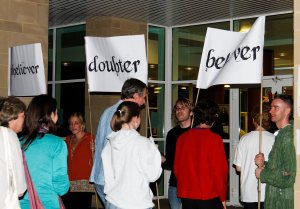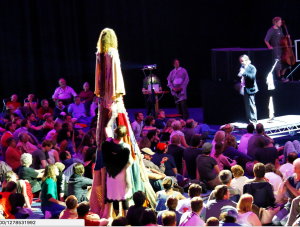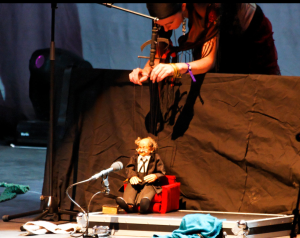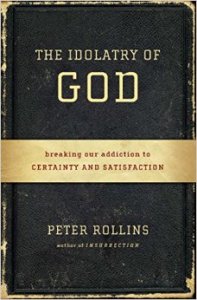We come now to the end of our reflections on the book, The Idolatry of God, by Peter Rollins, with the final chapter, “Want to Lose Belief? Join the Church”.
It would be easy to dismiss Rollins as some young hipster dude who spends far too much time with Žižek and Lacan than with Jesus and Paul. However, though he may come across as pretentious and even heretical to some, I believe he has something valuable for us to hear. At the very least, if he provokes us to rethink our assumptions, prejudices and traditions, then that is not a bad thing.
The demand upon our lives is the demand that we should pursue our happiness and fulfillment at all costs. It is then as important as ever that we create clearings where we are invited to give up this vision, spaces where we the deception of this demand is exposed and where we can simply learn to be. Where instead of certainty and satisfaction, we can embrace unknowing and celebrate life without the felt need to be complete.
Given that most churches are not comfortable with questions, doubts and challenges to the status quo, Peter argues that it will require “the formation of collectives that invite us to leave our cultural, political, and religious views at the door.” He goes on to present three case studies, attempts to “embody these ideas in liturgical form” at ikon, a collective he helped form in Belfast.
Case Study 1: Fundamentalism
While attendees were waiting for the venue’s doors to open, there was a group (planted unknownst to the participants) of protestors who denounced ikon as heretical with their chants and tracts they passed out. As tensions began to mount, the doors finally opened and the attendees gladly made their way inside.
They are confronted by a “large, stark stage” with five motionless people and a large wooden soapbox. Around the room are hundreds of pages from the Bible, crumpled up “like rocks ready to be thrown”. Seats are arranged to face the stage “to resemble a traditional church environment”. One of the five people step up onto the soapbox and reads John 14:6; after he steps back to place, another man comes to the stage and begins playing a “contemporary worship song connected loosely with the Bible verse” just read. But as they reach the second verse, various phrases begin to overlay themselves over the lyrics:
I am the truth
Follow me
Be my friend
I shall crush my enemies beneath my feet
I am the way
It is my way or no way
I am the truth
There is no truth for those who would reject me
I am life
There is only death for those who displease me
Love me
Or I will hate you
I am the truth
Follow me
Be my friend
Or I will destroy you
The musician then gave his testimony of how he lost his Christian faith. As he left the stage,
a young woman who had been standing silently in the background stepped forward and stood on the soapbox. She paused for a moment and looked out into the crowd. Then she opened her mouth to speak, but nothing came out. She stammered for a moment, paused, then cleared her throat. But again no sound came from her lips. After a minute or so of this hesitation and silence, she simply hung her head in shame adn returned to her spot on the stage.
Then a passage from 1 Corinthians 14 is projected on the wall behind her: “the women should keep silent in the churches. For they are not permitted to speak, but should be in submission, as the Law also says” (vs. 34; ESV). Next, another woman steps onto the soapbox and eloquently preaches a deeply moving sermon entitled “The Singing Ministry of Christ”, a “grace-filled reflection that overflowed with the themes of forgiveness and love.” Immediately after she concluded the sermon, the speakers crackled loudly through the speakers and a voice of an “infamous fundamentalist preacher … boomed loudly around the room”, preaching the same beautiful sermon, which he composed.
After this, another musician took to the stage and “sang a hymn full of brokenness and humility”. Meanwhile, ushers gave each person a piece of rice paper with a doctrine written in food coloring. After the song, another man on the stage took to the soapbox and spoke of how our beliefs serve as barriers to genuinely encountering others whom we disagree with. Finally, a young woman asked everyone to reflect on their beliefs and then turn to the person beside them and say, “These are my beliefs, broken for you”, followed by everyone consuming the rice paper.
The gathering closed with everyone encouraged to take home one of the crumpled Bible pages home as aid to further contemplation.
Case Study 2: The God Delusion
Attendees are confronted with three different doors to enter in through, each labeled with a large banner: “believer”, “unbeliever” and “doubter”.

Actually, all doors led to the “lobby where some stalls had been set up that offered various exotic-looking pills and potions.” People at the booths were pitching free samples, claiming they would help fill the void in our lives and heal our hearts. Other people were mingling with the crowd offering bandages with words like “Faith” ,”Wealth”, “Health”, “God”, etc. or passing out small vials labeled “the solution”.
The door at the other end of the lobby led into the main room where attendees were confronted by an 18 feet tall woman in a multi-coloured dress, with pieces of yarn from her dress stretched in all directions, leading to various people’s knitting needles.

The small stage was empty save for a tiny marionette against a dark curtain. A single light bulb hung from the ceiling over the stage. Off to one side of the stage, a woman sat unfolding origami cranes. The Nicene Creed is projected onto the walls and people are invited to use the computer on the desk to add or take away words from the Creed.
A young man gets on the stage and pulls the string to turn on the light bulb, and addressed the audience, saying he heard the voice of God — at this point the giant woman said, “I do not exist”. The young man continued, “It seemed as if I was being confronted with the loss of God instigated by none other than God …”

He switched off the light and a spotlight fell on the marionette, which began to move and began to tell a story about a caretaker, a priest and a refugee.
Next, a young man turns on the light bulb and began to ask, Where does your faith lie?
When he finished speaking, the young woman off to the side of the stage who was unfolding the cranes, “stopped what she was doing and addressed the crowd”:
I am trying to learn origami by going backwards. I have stolen a paper crane from the shoebox of junk in the corner and am unfolding it slowly, stopping with each reversing stage to commit the shape and passing landmarks to memory. I quickly discover that it doesn’t work. When I reach the beginning of all this unravelling I am forced to accept that, despite its map of lines and creases, what lies before me on the table is just a piece of paper and I am powerless to turn it back into a bird.
Another person went over and joined her, taking a crane and pulling it apart and began to speak:
Here I am unravelling!
It began with a doubt. A tickling thread, an element itching. Not much, but at the time I wanted it gone; I prayed for it to disappear.
Unravelling. Some early questions coming out of the fray: How can I claim to know God? How can I comfortably address Infinite-God in prayer? What is my faith made of?
…
Ravelling. Disentangling, not collapsing. My faith didn’t unravel, it ravelled. They mean the same thing. I learned to revel in ravelling. The questions proclaim more than the answers. The searching confirms that there has been revelation. The hunt for an unattainable treasure confirms that we have found it. Tearing apart what I love is evidence that I love it.
Forever doubting! Forever failing! Forever uncertain!
I am ravelling.
Then a woman who had been busy knitting stood up and spoke:
Things come apart. The centre cannot hold.
As soon as I was knit together in my mother’s womb I began to unravel.
Suddenly realised that I did not know God. And as I thought that most terrifying of thoughts, he left me. …
God left me.
Things come apart.
The god with the answers was gone. The god with my security was gone. The god with my future, secretly stored until the appointed time of its revelation, was gone. …
I remember the exact moment of my undoing. The moment where I realised that all my answers had to change because I had changed. …
And it is now my observation that my god is in the business of unravelling. God is not keeping me all together, wrapped up in swaddling clothes to keep me safe, or bandages to hold me in, or a shroud to mask my death. Because the only real safety is in death. And I was born to unravel myself down the path of life towards life.
People were then invited to share their edits of the Nicene Creed. “Threads that had been cut from the dress of the giant woman were distributed by the ushers who said, ‘Pull yourself apart,’ while tying them around people’s wrists.” Finally, the marionette told one final story about two rabbis arguing over a passage. At the conclusion of the parable, God offers to tell the rabbis what it means, but before He can, both rabbis look up and say to God, “Who are you to tell us what the verse means? You have given us the words, now leave us in peace to wrestle with it.”
The gathering closes with a benediction entitled “Go in Pieces” by Pádraig Ó Tuama.
Case Study 3: Pyro-theology
Rollins describes this liturgical experience thus:
Once through the doors everyone had to walk along a short blacked-out corridor with a fire alarm sounding and a woman’s voice, repeating, “There is a fire inside the building, please remain calm and step inside.” On the other side, people were given a page from a religious text that was being ripped out of a book at random.
Small unlit bonfires lay dotted around the room, while a large funeral pyre stood at the front with five people on top of it, blindfolded and wearing burnt clothing.
A version of the song “This Little Light of Mine” played as people found a place to sit.
A huge image of a burning church filled the wall behind the funeral pyre, while a man positioned on a smaller stage was quietly attempting to set alight a large Bible with flint and some kindling.
Then one of the people on the funeral pyre began to read from a large old book with his blindfold still on (see Peter Rollins, Insurrection, 2011; p. 137,138). Basically the story is about God separating the sheep from the goat, the wheat from the chaff. The earth was overflowing with suffering and pain, and a heartbroken God invites those who wish to escape the horrors of the world and in “an instant, millions were caught up in the clouds and ascended into the heavenly realm, leaving the suffering world behind them.” The twist in the ending is that God and the angels leave Heaven to take up residence in the earth with those “who would forsake heaven to embrace the earth” with all its suffering and pain.
After this, a well-dressed man gets on stage and shares some words from St. Cosmas of Aetolia, interspersed with songs about fire, child abuse in the Catholic Church in Ireland, poetry and personal reflectiions. Each time he came back to the stage to quote more from St. Cosmas, his clothes were more and more burnt.
If you want to find perfect love, go sell all your belongings, give them to the poor, go where you find a master and become a slave. Can you do this and be perfect?
You say this is too heavy? Then do something else. Don’t sell yourself as a slave. Just sell your belongings and give them all to the poor. Can you do it? Or do you find this too heavy a task?
All right, you cannot give away all your belongings. Then give half, or a third, or a fifth. Is even this too heavy? Then give one tenth. Can you do that? Is it still too heavy?
How about this. Don’t sell yourself as slave. Don’t give a penny to the poor. Only do this. Don’t take your poor brother’s coat, don’t take his bread, don’t persecute him, don’t eat him alive. If you don’t want to do him any good, at least do him no harm. Just leave him alone. Is this also too heavy?
You say you want to be saved. But how? How can we be saved if everything we are called to do is too heavy? We descend and descend until there is no place further down. God is merciful, yes, but he also has an iron rod.
Rollins’ describes what happens next: “After some silence one of the people on the funeral pyre removed her blindfold and led everyone in a call and response liturgy on the theme of burning away the old to make room for the new.”
The response consisted of crinkling the paper they were given at the beginning, “creating a wave of rustling that moved across the room that sounded like fire.” Then everyone was encouraged to burn the paper in one of the bonfires, thus symbolizing that our “religious narratives are but ash before the all-consuming fire of divine mystery.”
A fire alarm sounded to end the meeting and as they left, people were given some matches and exhorted to “go start a fire.”
Read Full Post »
 Whew! I am relieved that my journey with Idolatry of God is finally over! Though of course, in many respects, it’s just beginning: the hard work of further reflecting on, critiquing, questioning, adapting and applying the ideas will be a daunting and difficult undertaking.
Whew! I am relieved that my journey with Idolatry of God is finally over! Though of course, in many respects, it’s just beginning: the hard work of further reflecting on, critiquing, questioning, adapting and applying the ideas will be a daunting and difficult undertaking.


